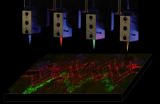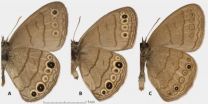(Press-News.org) While taking in the scenery during long road trips, passengers also may be taking in potentially harmful ultrafine particles (UFPs) that come into the car through outdoor air vents. Closing the vents reduces UFPs, but causes exhaled carbon dioxide to build up. Now, scientists report in the ACS journal Environmental Science & Technology that installing a newly developed high-efficiency cabin air filter (HECA) could reduce UFP exposure by 93 percent and keep carbon dioxide levels low.
Yifang Zhu and Eon Lee explain that most modern cars come with cabin air filters, but they only block 40-60 percent of the UFPs when in "outdoor air mode." These particles are 100 nanometers or less in diameter; about a thousand of them could fit across the width of a human hair. Studies suggest that UFPs, which are found in automotive exhaust, may be linked with health problems. Switching the venting system into "recirculation mode" reduces UFPs by 90 percent, but because the interior is closed off from the outside, exhaled carbon dioxide can potentially build up to levels that could impair decision-making. To address this challenge, Zhu and Lee decided to develop a method that would simultaneously reduce UFPs inside cars, while also allowing carbon dioxide to escape.
They developed HECA filters that could reduce UFP levels by an average of 93 percent in 12 commercially available vehicles while driving in outdoor air mode. Compared with the original manufacturer-installed filters, the new one is made of synthetic fibers of much smaller diameters. Carbon dioxide remained at a "reasonable" level, they say.
INFORMATION:
The authors acknowledge funding from the California Air Resources Board and the National Science Foundation.
The American Chemical Society is a nonprofit organization chartered by the U.S. Congress. With more than 161,000 members, ACS is the world's largest scientific society and a global leader in providing access to chemistry-related research through its multiple databases, peer-reviewed journals and scientific conferences. Its main offices are in Washington, D.C., and Columbus, Ohio.
To automatically receive news releases from the American Chemical Society, contact newsroom@acs.org.
Follow us: Twitter | Facebook
Special air filter blocks small particles called UFPs from getting inside cars
2014-02-19
ELSE PRESS RELEASES FROM THIS DATE:
Kinetic battery chargers get a boost
2014-02-19
New technology to capture the kinetic energy of our everyday movements, such as walking, and to convert it into electrical energy has come a step closer thanks to research to be published in the International Journal Biomechatronics and Biomedical Robotics.
Researchers have for many years attempted to harvest energy from our everyday movements to allow us to trickle charge electronic devices while we are walking without the need for expensive and cumbersome gadgets such as solar panels or hand-cranked chargers. Lightweight devices are limited in the voltage that they ...
A*STAR scientists discover protein's role in human memory and learning functions
2014-02-19
1. Scientists at A*STAR's Institute of Molecular and Cell Biology (IMCB) have identified the precise role of the protein, SNX27, in the pathway leading to memory and learning impairment. The study broadens the understanding of the brain's memory function and could be used to explain defects in the cognitive development of those with Down's syndrome. The newly established knowledge could potentially facilitate exploration of strategies to improve memory and learning abilities in Down's syndrome.
2. Down's syndrome is a genetic condition characterized by the presence ...
Could metabolism play a role in epilepsy?
2014-02-19
VIDEO:
The Kuehner lab demonstrates their drug-screening technique in JoVE's peer-reviewed video format to aid other researchers in the field.
Click here for more information.
February 19—Researchers from the Franciscan University of Steubenville, Ohio are exploring a possible link between metabolic defects and seizures. They determined that diet could influence susceptibility to seizures, and they have identified a common diabetes drug that could be useful in treating disorders ...
An essential step toward printing living tissues
2014-02-19
BOSTON — A new bioprinting method developed at the Wyss Institute for Biologically Inspired Engineering at Harvard University and the Harvard School of Engineering and Applied Sciences (SEAS) creates intricately patterned 3D tissue constructs with multiple types of cells and tiny blood vessels. The work represents a major step toward a longstanding goal of tissue engineers: creating human tissue constructs realistic enough to test drug safety and effectiveness.
The method also represents an early but important step toward building fully functional replacements for injured ...
Antidepressant holds promise in treating Alzheimer's agitation
2014-02-19
Feb. 19, 2014 (Toronto) - An antidepressant medication has shown potential in treating symptoms of agitation that occur with Alzheimer's disease and in alleviating caregivers' stress, according to a multi-site U.S.- Canada study.
"Up to 90 per cent of people with dementia experience symptoms of agitation such as emotional distress, restlessness, aggression or irritability, which is upsetting for patients and places a huge burden on their caregivers," said Dr. Bruce G. Pollock, Vice President of Research at the Centre for Addiction and Mental Health (CAMH), who directed ...
'Beautiful but sad' music can help people feel better
2014-02-19
New research from psychologists at the universities of Kent and Limerick has found that music that is felt to be 'beautiful but sad' can help people feel better when they're feeling blue.
The research investigated the effects of what the researchers described as Self-Identified Sad Music (SISM) on people's moods, paying particular attention to their reasons for choosing a particular piece of music when they were experiencing sadness - and the effect it had on them.
The study identified a number of motives for sad people to select a particular piece of music they perceive ...
Stratification determines the fate of fish stocks in the Baltic Sea
2014-02-19
With its narrow connection to the North Sea, strong currents, a large number of river estuaries and a bottom profile marked by ridges, basins and troughs, the Baltic represents an inland sea with highly different water qualities. The fact that these morphological and hydrographic conditions can also influence the fate of fish stocks has now been shown by a team of fisheries biologists from GEOMAR Helmholtz Centre for Ocean Research Kiel and the National Institute of Aquatic Resources (DTU Aqua) at the Technical University of Denmark. For their publication in the international ...
Dreams, deja vu and delusions caused by faulty 'reality testing'
2014-02-19
New research from the University of Adelaide has delved into the reasons why some people are unable to break free of their delusions, despite overwhelming evidence explaining the delusion isn't real.
In a new paper published in the journal Frontiers in Psychology, University of Adelaide philosopher Professor Philip Gerrans says dreams and delusions have a common link – they are associated with faulty "reality testing" in the brain's higher order cognitive systems.
"Normally this 'reality testing' in the brain monitors a 'story telling' system which generates a narrative ...
A challenge to the genetic interpretation of biology
2014-02-19
A proposal for reformulating the foundations of biology, based on the 2nd law of thermodynamics and which is in sharp contrast to the prevailing genetic view, is published today in the Journal of the Royal Society Interface under the title "Genes without prominence: a reappraisal of the foundations of biology". The authors, Arto Annila, Professor of physics at Helsinki University and Keith Baverstock, Docent and former professor at the University of Eastern Finland, assert that the prominent emphasis currently given to the gene in biology is based on a flawed interpretation ...
Two new butterfly species discovered in eastern USA
2014-02-19
Butterflies are probably best-loved insects. As such, they are relatively well studied, especially in the United States. Eastern parts of the country are explored most thoroughly. First eastern US butterfly species were described by the father of modern taxonomy Carl Linnaeus himself, over 250 years ago. For the last two and a half centuries, naturalists have been cataloguing species diversity of eastern butterflies, and every nook and cranny has been searched. Some even say that we learned everything there is to know about taxonomy of these butterflies.
Discovery of ...



